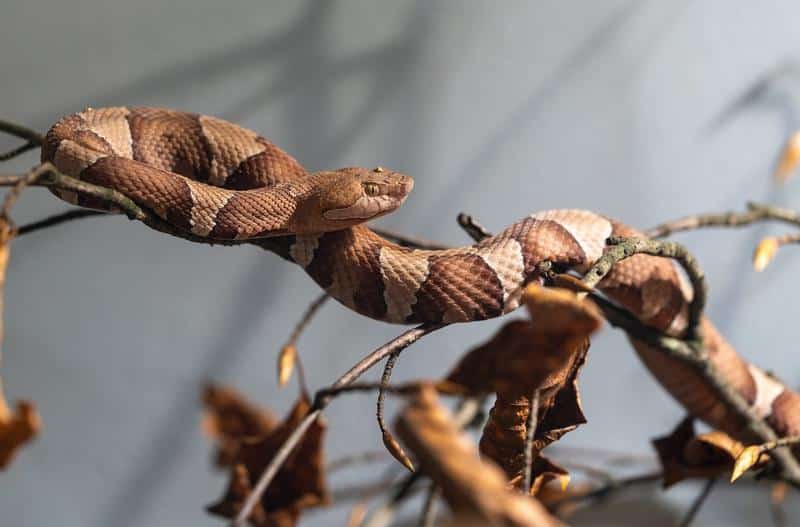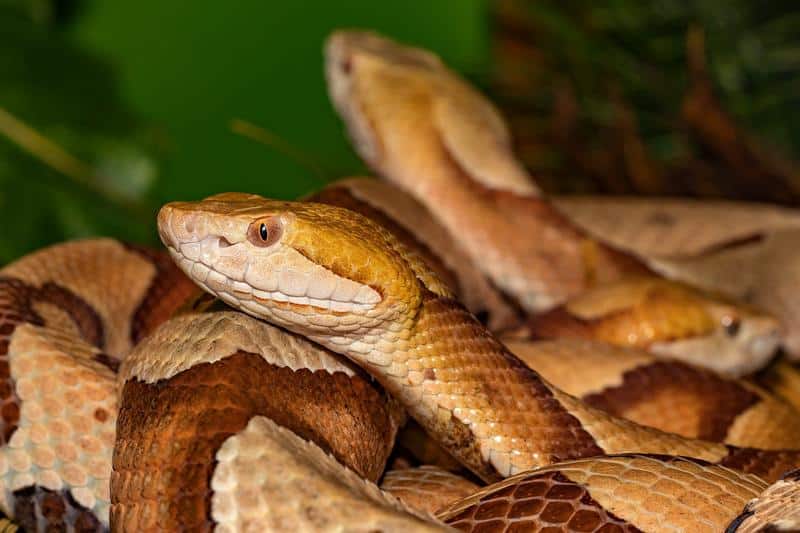Copperhead Dog Bite: Treatment, Symptoms, Long-Term Effects
Have a copperhead dog bite that needs treatment? In this article, we’ll tell you what to do right away to keep your dog safe before teaching you the command you’ll need to prevent any future incidents. If you’re not sure if it actually happened, a dog bitten by copperhead will show certain symptoms, and we’ll tell you what to look for.
Next, we’ll discuss home treatments like Benadryl for when a copperhead bites your dog before filling you in on the (excellent) copperhead bite dog survival rate. Finally, we’ll finish by giving you more information you should know, like if copperheads are aggressive, what copperheads look like, and how to get rid of copperheads. Keep reading!
Copperhead Bites Dog

Copperhead bites on dogs can indeed pose a serious threat to your pet’s health. Immediate veterinary attention is crucial if you suspect you have a dog bit by a copperhead, as venom can cause significant tissue damage and other complications.
If your dog is bitten by a copperhead, keep calm and seek veterinary assistance immediately, making sure to not waste any time as rapid treatment can be the difference between a mild reaction and a serious one.
Dog Bitten by Copperhead, What to Do
A dog bitten by a copperhead needs you to keep calm and act quickly. Remove your dog from the vicinity of the snake, but avoid attempting to capture or kill the snake as this could lead to additional bites.
Do not apply a tourniquet, cut into the bite, or try to suck out the venom, as these actions can cause further harm. Instead, limit your dog’s movement as much as possible to prevent the venom from spreading. Transport your pet to a vet clinic immediately for professional treatment.
Your vet will be able to assess the severity of the bite and administer antivenom if necessary.
Dog Bit by Copperhead Symptoms
Copperhead dog bites usually result in immediate pain and swelling. Other symptoms may include drooling, vomiting, lethargy, difficulty breathing, and shock. In some severe cases, muscle damage, organ damage, or even death can occur.
However, the severity of the symptoms will depend on several factors, including the location of the bite, the size of the dog, and the amount of venom injected.
Copperhead Bite on Dog: Are They Poisonous?
Yes, copperheads are venomous snakes and their bites can be potentially harmful to dogs. The venom primarily causes localized tissue destruction and pain, but systemic effects can occur. While copperhead venom is not typically as potent as that of other venomous snakes, it can still cause significant damage, especially if the bitten dog is small or the bite is not treated promptly.
Train the “Leave It” Command
One of the best ways to protect your dog from snake bites is to train them to understand the “Leave It” command. This command teaches your dog to immediately stop what they are doing, which can be particularly useful if they encounter a snake.
Steps to Train the “Leave It” Command:
- Start by holding a treat in your closed hand. When your dog tries to get it, say “Leave it.”
- Once your dog stops trying and pulls away, say “Good!” and give them a different treat from your other hand.
- Repeat this exercise multiple times until your dog stops trying to take the treat when you give the command.
- Gradually increase the difficulty by placing the treat on the floor and covering it with your hand. Follow the same process, rewarding your dog for obeying the command.
- Once your dog is consistently obeying the command, you can try practicing it in different environments and with different distractions.
Train the “Stay” Command
The “Stay” command can also be useful in keeping your dog safe. It teaches them to remain still and not move until you give them permission.
Steps to Train the “Stay” Command:
- Ask your dog to sit or lie down.
- Hold your hand up like a stop sign and say “Stay.”
- Take a step back. If your dog stays put, reward them with praise and a treat.
- Gradually increase the distance between you and your dog, always rewarding them for staying put.
- Remember to practice this command frequently and in different locations to help your dog understand they need to stay put until you say it’s okay to move.
These steps will get your dog to stay away from copperheads, but it’s important to remember that the underlying behavioral issues (prey drive, aggression, dominance, etc.) that were causing all of this to begin with will still be present. And until you address those, any positive changes you see are only going to be temporary.
“Well, how do I make these changes last?”
By getting your dog to truly choose to follow your direction, that’s how. I tried many times to write out how you can do that before deciding it made more sense to just link you to the free video series that explains it better than I’d ever be able to.
The series is by a man named Dan who is one of the world’s leading dog obedience trainers. In it, he teaches you how to put an end to things like your dog going after copperheads and all other misbehavior using his fast and easy-to-follow methods.
In the first video, Dan will reveal to you why the two most common methods of dog training only doom you to failure. You can watch the video now by clicking here. Follow the proven system he’ll show you in his series and you’ll never have to spend another second worrying about your dog chasing copperheads ever again!
Copperhead Snake Bite Dog Home Treatment

Copperhead bites on dogs always warrant immediate veterinary attention, but there are certain steps you can take at home to help your pet. However, remember that these should not replace professional treatment. It’s crucial to get your dog to the vet as quickly as possible after a snake bite.
Copperhead Bite Dog Benadryl Treatment
Benadryl, or diphenhydramine, can potentially be used in snake bite situations to help manage allergic reactions. It can help control swelling and alleviate symptoms such as itching or hives. However, it’s not a cure for a snake bite and is no substitute for professional veterinary care. Before administering any medication to your pet, always consult with a veterinarian.
If your vet approves the use of Benadryl, ask them for the correct dosage amount and frequency for your dog’s body weight. Make sure to only use plain Benadryl, as formulas containing acetaminophen or pseudoephedrine can be harmful to dogs.
Copperhead Bite Dog Survival Rate
The survival rate for dogs bitten by a copperhead is very good with prompt and appropriate treatment. Most dogs recover with aggressive supportive care and pain management. However, the outcome can depend on many factors including the location and severity of the bite, the dog’s size and health status, and how quickly treatment is administered.
How to Keep Your Dog Safe From Snakes
Prevention is the best way to protect your dog from snake bites. Keep your yard clear of tall grass, piles of wood, and other places where snakes might hide. When walking your dog, keep them on a leash and stay on clear paths away from tall grass and rocks.
Training your dog to obey commands like “Leave it” and “Stay” can also help keep them safe if they encounter a snake. We explain how to do both in the first section.
You definitely want to get this taken care of now, as it will also keep your dog safe in other future snake encounters. You then won’t have to worry about things like black rat snake dog bites, king snake dog bites, corn snake dog bites, garter snake dog bites, or milk snake dog bites because you’ll know your pup will stay away.
Copperhead Bite Dog Symptoms

Symptoms of a copperhead bite in dogs may include severe pain, swelling, weakness, vomiting, difficulty breathing, and lethargy. If you suspect your dog has been bitten by a copperhead, it is critically important to seek immediate veterinary attention. Quick and appropriate action can help mitigate the effects of the venom and improve your pet’s prognosis.
- Severe Pain: Copperhead snake venom is highly painful, and your dog is likely to feel it instantly. One of the most immediate and noticeable symptoms of a copperhead bite is intense pain at the site of the bite. Your dog may react strongly, yelping, whimpering, or showing signs of extreme discomfort. The pain may also cause your pet to favor or protect the affected area.
- Swelling: Swelling is another common symptom of snake bites, including those from copperheads. The area around the bite site is likely to swell noticeably within a short period. This swelling is due to the local effect of the venom, which causes inflammation and tissue damage.
- Weakness: As the venom circulates through the body, it can lead to a general feeling of malaise and muscle incoordination, presenting as overall weakness. Your dog may appear unsteady on its feet, have trouble standing or moving around, and even collapse in severe cases.
- Vomiting: The venom of a copperhead snake can cause significant gastrointestinal upset, often leading to vomiting. If your dog starts vomiting after a suspected snake bite, it’s a clear sign that the venom is having systemic effects and immediate veterinary care is necessary.
- Difficulty Breathing: In more severe cases of copperhead bites, the venom can affect the dog’s respiratory system. This may result in your dog having trouble breathing, showing signs of respiratory distress like panting, gasping, or shallow, rapid breathing.
- Lethargy: Lastly, lethargy or a decrease in activity level can be another telling sign of a copperhead dog bite. Your dog may appear unusually tired, listless, or unresponsive, which could be a result of the venom’s systemic effects on the body.
In conclusion, if you observe any symptoms such as severe pain, swelling, weakness, vomiting, difficulty breathing, or lethargy in your dog after a suspected snake bite, do not delay in seeking veterinary help. Remember that early and appropriate treatment can significantly enhance your furry friend’s chances of a full recovery and decrease the likelihood of long-term complications.
Learn how to prevent future encounters in the first section.
Are Copperheads Aggressive?
Copperheads are not aggressive snakes typically. They tend to be more defensive in nature, often resorting to biting only when they feel threatened or cornered. However, as with any wild animal, behavior can vary among individuals, and it’s crucial to exercise caution when in areas where these snakes are common to protect yourself and your pets.
Copperhead Snake Bite Warning Signs
Despite their relative lack of aggression, a defensive bite from a copperhead can still be harmful, especially to pets. Copperheads are venomous snakes, and a bite can cause significant discomfort and health complications. It’s important to recognize the warning signs of a potential copperhead encounter.
These snakes will often vibrate their tails rapidly when they feel threatened. While they don’t have a rattle, the vibrating tail against dry leaves can produce a similar sound. They may also assume a defensive posture with the head pulled back ready to strike.
If your dog has been bitten, signs may include severe pain, swelling at the bite site, weakness, drooling, and sometimes vomiting. If your dog exhibits these symptoms, especially after a walk in a wooded area, it’s crucial to get them to a vet immediately.
Preventing Snake Bites in Dogs
The best way to keep your dog safe from a copperhead, or any snake, is through prevention. Keeping your dog on a leash, particularly in areas known to house snakes, can help prevent encounters. Stick to clear, well-trodden paths where snakes will be more visible, and avoid tall grass or piles of leaves and debris where snakes could be hiding.
Training Dogs to Avoid Snakes
Training your dog to avoid snakes can be another effective preventative measure. This could involve teaching your dog a “Leave it” command to discourage them from investigating potentially dangerous animals or objects. We explain how to do it in the first section.
Copperhead Snake Habitat
Understanding where copperheads live can also help prevent unwanted encounters. Copperheads can be found in a variety of habitats, including forests, swamps, rocky areas, and suburban neighborhoods.
They often hide under leaves, logs, and rocks. If you live in an area where copperheads are common, be particularly vigilant during the warmer months when these snakes are more active.
What Do Copperheads Look Like?
Copperheads are medium-sized venomous snakes recognized by their distinct copper-red heads, hence their name. Their bodies feature hourglass-shaped crossbands that are narrow in the center and wider on the sides, with coloration that blends between tan, brown, and pink.
What Are Copperheads?
Copperheads (Agkistrodon contortrix) belong to the pit viper family, which includes other venomous snakes like cottonmouths and rattlesnakes. They have thick bodies that can grow up to 3 feet in length, although some larger specimens have been recorded.
Copperheads have a broad, triangular-shaped head that distinguishes them from many non-venomous species. The snake’s pupils are vertical, similar to a cat’s, and they possess heat-sensitive pits between their eyes and nostrils, which help them detect warm-blooded prey.
Where Are Copperheads Found?
Copperheads inhabit a wide range of habitats across the eastern and central United States. They are typically found in forests, rocky areas, swamps, and even suburban neighborhoods. These snakes often hide under leaves, logs, and rocks, and can sometimes be found near water sources.
Homeowners may encounter them in gardens or yards, particularly in areas with plenty of cover and rodent activity.
How Far Do Copperheads Travel From Their Den?
Copperheads are not highly migratory snakes, and they tend to stay relatively close to their dens. However, they may travel short distances to find food, mates, or suitable basking spots. The range of a copperhead can vary, but it typically revolves around a radius of a few hundred yards from its den or summer residence.
Distinguishing Copperheads from Other Snakes
It’s important to be able to distinguish copperheads from non-venomous snakes, especially if you live in an area where they are prevalent. Many non-venomous species, like the harmless Northern Watersnake or Corn Snake, have patterns that can be confused with copperheads.
Always remember, though, no snake should be handled unless by a professional, as misidentification can lead to unnecessary risk and potential harm to the snake.
Preventing Copperhead Encounters
In areas with known copperhead populations, take steps to make your property less attractive to these snakes. This can include removing potential hiding spots such as woodpiles, controlling rodent populations, and maintaining your lawn to prevent ideal environments for these snakes.
As with all wildlife, remember that copperheads play a valuable role in the ecosystem by controlling rodent and insect populations.
How to Get Rid of Copperhead Snakes
Successfully and safely eliminating copperhead snakes from your property involves a combination of modifying the environment to make it less attractive to them, employing natural repellents, and seeking professional help when necessary.
Ensuring your yard is free of clutter, securing potential food sources, using snake-proof fences, employing natural predators, and using commercially available snake repellents can all contribute to a copperhead-free property. It’s important to handle this issue cautiously to protect both the humans and pets living in your household.
- Modify the Environment: Copperheads, like other snakes, are attracted to areas with plenty of cover and food sources. By removing debris, logs, rock piles, and tall grass, you make your yard less appealing to them. Properly sealing your garbage bins can also help to discourage rodents, which in turn can dissuade snakes looking for food.
- Secure Potential Food Sources: Copperhead snakes feed on mice, small birds, and amphibians. By reducing these food sources, you can make your property less enticing. This can be achieved by ensuring your home and yard are free from potential nesting sites for rodents and keeping bird feeders away from the ground.
- Snake-Proof Fencing: Installing a snake-proof fence around your property can prevent copperheads from entering. These fences should be buried a few inches into the ground and be slanted outward at a 30-degree angle to deter snakes from climbing over.
- Employ Natural Predators: Certain animals, such as king snakes, hawks, and foxes, are natural predators of copperhead snakes. By creating a welcoming habitat for these animals, you can control the copperhead population in your area. However, always consider the overall impact on your ecosystem before introducing new species.
- Commercial Snake Repellents: There are numerous commercial snake repellents available that can deter copperheads. These typically use strong odors to disorient and repel snakes. Always use these products as directed and keep them out of reach of children and pets.
In conclusion, removing copperhead snakes from your property involves a multifaceted approach. While these tips can help reduce the likelihood of a copperhead encounter, if you come across one, it’s always safer to call a professional snake remover. They have the skills and knowledge to handle the situation without causing harm to the snake, the people, or the pets involved.
I’m sure you’re ready to not worry about this anymore, so I’ll let you get started on everything now. Good luck with all of this, and thanks for reading our article “Copperhead Dog Bite: Treatment, Symptoms, Long-Term Effects.”





